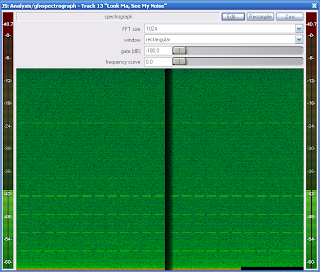Recently I posted a review of the Lightsnake USB Instrument Cable. In that review, I gave it decent marks in my experience - no errant line noises like some people claimed to have heard (I even parroted the corporate "must be a bad cable" approach to people's problems.) I have once again proven to myself that you will get different results with different gear. At the time I wrote that review, I had only one guitar to try with it, a Daisy Rock Wildwood Electric/Acoustic Guitar. So my review reflect my experience with it at that time. The extra environmental noise normal with an acoustic guitar in a non-soundproofed environment caused me to always put a gate in the effects chain to clean it up. The natural fullness of sound from the acoustic guitar came across nicely and I was satisfied that the (gated) recorded material was fairly accurate to the original sound.
I recently picked up an Epiphone SG Special, which is an admittedly low-end electric guitar. Of course, I plugged it into the Lightsnake. My first reaction was "what in the heck is that racket?" The racket was, unfortunately, an electric pulsing noise over the monitors I never noticed previously (thanks to the gate). Okay, fine. I put a gate in the chain, and did some trial recording with the SG. The gate worked to take off the noise in the silent sections. But as soon as you hit anything loud and sustained (like a chord progression), the noise was embedded in the louder sections. I also tried using the ReaFIR VST in Subtraction mode to build a noise profile. Again, it works fine for trimming the noise off in silent or very light, quick notes, but if you have any continuous playing, you can hear the noise interlaced with your guitar sound.
 I took a shot of a spectrograph of the line noise with the Lightsnake plugged into the SG with the volume knob set to zero. What you see is a wash of noise, with a lot of other structured pulses embedded in it. I checked old recordings from the Acoustic - I see the same "pulse signature" in the signal. I think the reason I never noticed it with the Daisy Rock on recording is that the acoustic is naturally a very full sound, so the noise was actually getting lost in the sound of the acoustic. Since the electric doesn't have the same wide-spectrum wash as the acoustic, the noisy cable is laid bare for all to see and hear.
I took a shot of a spectrograph of the line noise with the Lightsnake plugged into the SG with the volume knob set to zero. What you see is a wash of noise, with a lot of other structured pulses embedded in it. I checked old recordings from the Acoustic - I see the same "pulse signature" in the signal. I think the reason I never noticed it with the Daisy Rock on recording is that the acoustic is naturally a very full sound, so the noise was actually getting lost in the sound of the acoustic. Since the electric doesn't have the same wide-spectrum wash as the acoustic, the noisy cable is laid bare for all to see and hear.So here I sit, eating my own words about my value shopping, and have to say I spent my money poorly. (However, I have been using it for 6 months or so before I came to that conclusion, so maybe it wasn't a total waste.) I heartily recommend saving your pennies (as I am) and save up for a more "pro" box. I'm currently looking at the Line 6 TonePort series, since it is more of a name brand with a lot more positive reviews.
Since this is the net, we can rewrite history, so I plan to. I have added the core of this post into my original Lightsnake review, so folks stumbling across it will be wiser that I was when I first wrote it.



No comments:
Post a Comment